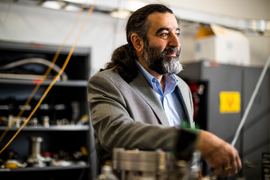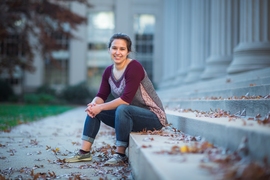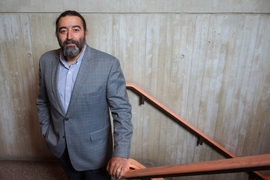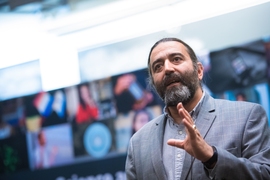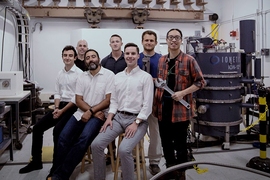Starting off as a junior helicopter pilot, Lt. Col. Jill Rahon deployed to Afghanistan three times. During the last one, she was an air mission commander, the pilot who is designated to interface with the ground troops throughout the mission.
Today, Rahon is a fourth-year doctoral student studying applied physics at the Department of Nuclear Science and Engineering (NSE). Under the supervision of Areg Danagoulian, she is working on engineering solutions for enforcement of nuclear nonproliferation treaties. Rahon and her husband have 2-year-old twins: “They have the same warm relationship with my advisor that I had with my dad’s (PhD) advisor,” she says.
A path to the armed forces
The daughter of a health physicist father and a food chemist mother, Rahon grew up in the Hudson Valley, very close to New York City. Nine-eleven was a life-altering event: “Many of my friends’ fathers and uncles were policemen and firefighters [who] died responding to the attacks,” Rahon says. A hurt and angry teenager, Rahon was determined to do her part to help: She joined the Army and decided to pursue science, becoming part of the first class to enter West Point after 9/11.
Rahon started by studying strategic history, a field that covers treaties and geopolitical relationships. It would prove useful later. Inspired by her father, who works in the nuclear field, Rahon added on a nuclear science and engineering track.
After graduating from West Point, Rahon wanted to join active combat and chose aviation. At flight school in Fort Novosel, Alabama, she discovered that she loved flying. It was there that Rahon learned to fly the legendary Chinook helicopter. In short order, Rahon was assigned to the 101st Airborne Division and deployed to Afghanistan quickly thereafter.
As expected, flying in Afghanistan, especially on night missions, was adrenaline-charged. “You’re thinking on the fly, you’re talking on five different radios, you’re making decisions for all the helicopters that are part of the mission,” Rahon remembers. Very often Rahon and her cohorts did not have the luxury of time. “We would get information that would need to be acted on quickly,” she says. During the planning meetings, she would be delighted to see a classmate from West Point function as the ground forces commander. “It would be surprising to see somebody you knew from a different setting halfway around the world, working toward common goals,” Rahon says.
Also awesome: helping launch the first training program for female pilots to be recruited in the Afghan National Air Force. “I got to meet [and mentor] these strong young women who maybe didn’t have the same encouragement that I had growing up and they were out there hanging tough,” Rahon says.
Exploring physics and nuclear engineering
After serving in the combat forces, Rahon decided she wanted to teach physics at West Point. She applied to become a part of the Functional Area (FA52) as a nuclear and countering weapons of mass destruction officer.
FA52 officers provide nuclear technical advice to maneuver commanders about nuclear weapons, effects, and operating in a nuclear environment or battlefield. Rahon’s specialty is radiation detection and operations in a nuclear environment, which poses unique threats and challenges to forces.
Knowing she wanted to teach at West Point, she “brushed up extensively on math and physics” and applied to MIT NSE to pursue a master’s degree. “My fellow students were such an inspiration. They might not have had the same life experiences that I had but were still so mature and driven and knowledgeable not only about nuclear engineering but how that fits in the energy sector and in politics,” Rahon says.
Resonance analysis to verify treaties
Rahon returned to NSE to pursue her doctorate, where she does a “lot of detection and treaty verification work.”
When looking at nuclear fuels to verify safeguards for treaties, experts search for the presence and quantities of heavy elements such as uranium, plutonium, thorium, and any of their decay products. To do so nondestructively is of high importance so they don’t destroy a piece of the material or fuel to identify it.
Rahon’s research is built on resonance analysis, the fact that most midrange to heavy isotopes have unique resonance signatures that are accessed by neutrons of epithermal energy, which is relatively low on the scale of possible neutron energies. This means they travel slowly — crossing a distance of 2 meters in tens of microseconds, permitting their detection time to be used to calculate their energy.
Studying how neutrons of a particular energy interact with a sample to identify worrisome nuclear materials is much like studying fingerprints to solve crimes. Isotopes that have a spike in likelihood of interaction occurring over a small neutron energy are said to have resonances, and these resonance patterns are isotopically unique. Experts can use this technique to nondestructively assess an item, identifying the constituent isotopes and their concentrations.
Resonance analysis can be used to verify that the fuels are what the nuclear plant owner says they are. “There are a lot of safeguards activities and verification protocols that are managed by the International Atomic Energy Agency (IAEA) to ensure that a state is not misusing nuclear power for ulterior motives,” Rahon points out. And her method helps.
“Our technique that leverages resonance analysis is nothing new,” Rahon says, “It's been applied practically since the '70s at very large beam facilities, hundreds of meters long with a very large accelerator that pulses neutrons, and then you're able to correlate a neutron time of flight with a resonance profile. What we’ve done that is novel is we've shrunk it down to a 3-meter system with a portable neutron residence generator and a 2-meter beam path,” she says.
Mobility confers many significant advantages: “This is something that could be conceivably put on the back of a truck and moved to a fuel facility, then driven to the next one for inspections or put at a treaty verification site. It could be taken out to a silo field where they are dismantling nuclear weapons,” Rahon says. However, the miniaturization does come with significant challenges, such as the neutron generator’s impacts on the signal to noise ratio.
Rahon is delighted her research can ensure that a necessary fuel source will not be misused. “We need nuclear power. We need low-carbon solutions for energy and we need safe ones. We need to ensure that this powerful technology is not being misused. And that's why these engineering solutions are needed for these safeguards,” she says.
Rahon sees parallels between her time in active duty and her doctoral research. Teamwork and communication are key in both, she says. Her dad is her role model and Rahon is a firm believer in mentorship, something she nurtured both in the armed forces and at MIT. “My advisor is genuinely a wonderful person who has always given me so much support from not only being a student, but also being a parent,” Rahon adds.
In turn, Danagoulian has been impressed by Rahon’s remarkable abilities: “Raising twins, doing research in applied nuclear physics, and flying coalition forces into Taliban territory while evading ground fire … [Jill] developed her own research project with minimal help from me and defended it brilliantly during the first part of the exam,” he says.
It seems that Rahon flies high no matter which mission she takes on.



